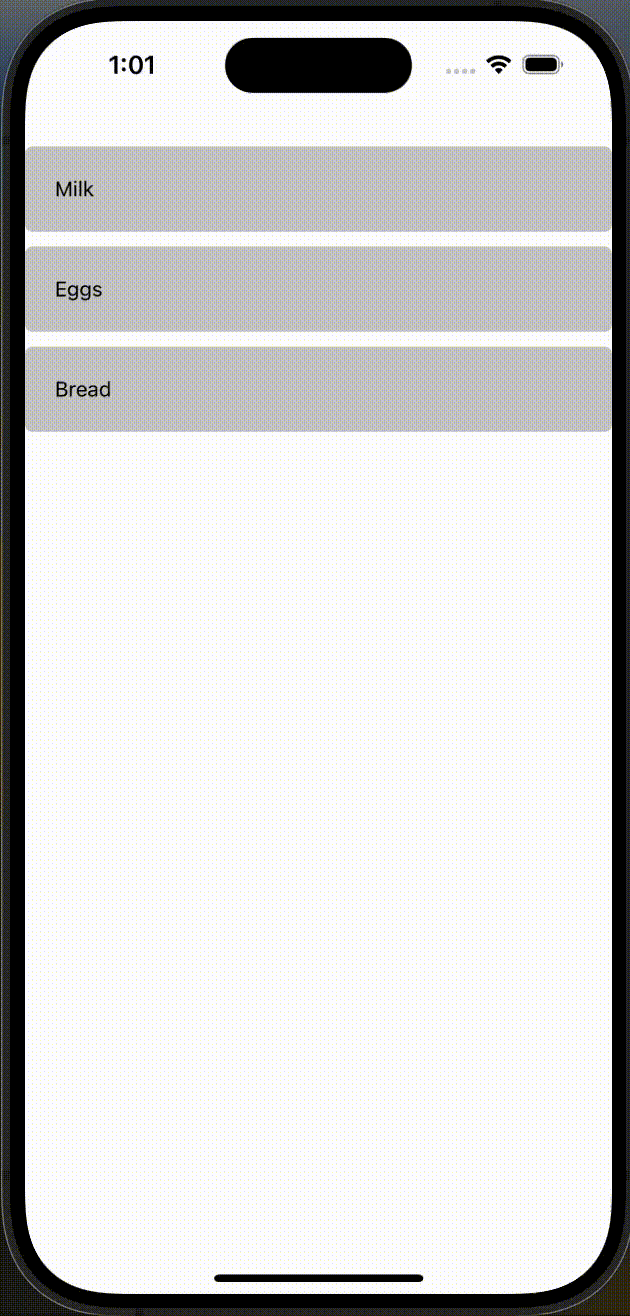Swipe gestures can make your app feel smooth, intuitive, and interactive. Whether you're building a to-do list, email app, or a grocery list, adding swipe gestures improves user experience by providing quick actions like deleting or archiving an item.
In this post, we’ll go through how to add swipe gestures to a grocery list in React Native, revealing a red delete icon when you swipe an item to the left.
Why Use Swipe Gestures?
Adding swipe gestures makes your app feel more responsive and modern. It’s also a great way to keep the UI clean by hiding actions until they’re needed.
What We’ll Build
We’ll create a simple grocery list where:
- Swiping an item to the left reveals a red delete icon.
- Tapping the delete icon removes the item from the list.
Getting Started
Before we begin, make sure you have react-native-gesture-handler installed
npm install react-native-gesture-handlerFor iOS, don’t forget to run
npx pod-installThen, wrap your app with GestureHandlerRootView in App.tsx
import { GestureHandlerRootView } from 'react-native-gesture-handler';
export default function App() {
return (
<GestureHandlerRootView style={{ flex: 1 }}>
{/* Your app content */}
</GestureHandlerRootView>
);
}Creating the Swipeable Grocery List Item
Now, let's create a swipeable list item that reveals a delete button using Swipeable.
Create a GroceryItem.tsx Component
import React from 'react';
import { View, Text, Pressable, StyleSheet } from 'react-native';
import { Swipeable } from 'react-native-gesture-handler';
interface GroceryItemProps {
item: string;
onDelete: () => void;
}
const GroceryItem: React.FC<GroceryItemProps> = ({ item, onDelete }) => {
const swipeableRef = React.useRef<Swipeable>(null);
const handleDelete = () => {
swipeableRef.current?.close(); // Close the swipeable after deletion
onDelete();
};
const renderRightActions = () => (
<Pressable style={styles.deleteButton} onPress={handleDelete}>
<Text style={styles.deleteText}>Delete</Text>
</Pressable>
);
return (
<Swipeable ref={swipeableRef} renderRightActions={renderRightActions}>
<View style={styles.item}>
<Text>{item}</Text>
</View>
</Swipeable>
);
};
const styles = StyleSheet.create({
deleteButton: {
backgroundColor: 'red',
padding: 20,
justifyContent: 'center',
alignItems: 'center'
},
deleteText: {
color: 'white',
fontWeight: 'bold'
},
item: {
backgroundColor: 'white',
padding: 20,
flex: 1,
marginVertical: 5,
borderRadius: 5
},
});
export default GroceryItem;Using the GroceryItem Component
Now, use this component inside your list.
import React from 'react';
import { FlatList, View } from 'react-native';
import GroceryItem from './GroceryItem';
const GroceryList: React.FC = () => {
const [items, setItems] = React.useState(['Milk', 'Eggs', 'Bread']);
const handleDelete = (index: number) => {
setItems(items.filter((_, i) => i !== index));
};
return (
<FlatList
data={items}
keyExtractor={(item, index) => index.toString()}
renderItem={({ item, index }) => (
<GroceryItem item={item} onDelete={() => handleDelete(index)} />
)}
/>
);
};
export default GroceryList;
Conclusion
With just a few steps, we’ve added swipe gestures to a React Native app using Swipeable, making our grocery list more interactive and user-friendly. This method can be extended to other actions like archiving emails, marking tasks as done, or revealing additional options.
Want to take it further? Try adding swipe-to-undo, haptic feedback, or even smooth animations using react-native-reanimated for a more polished feel. 🚀
